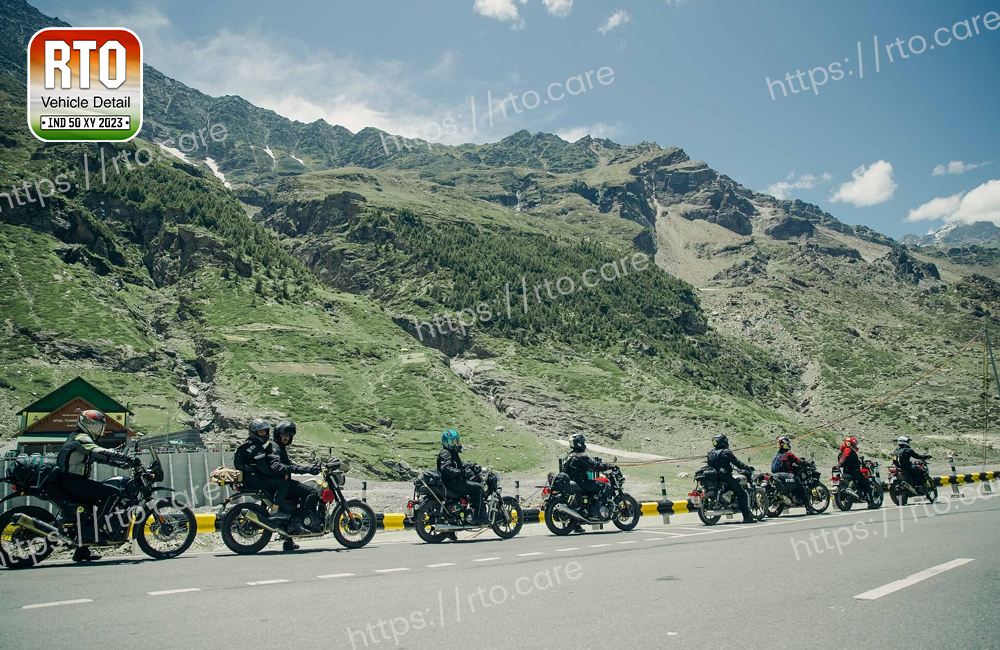Planning beforehand and having the right equipment are key for a safe and fun bike trip over the gorgeous Himalayas. Having the appropriate gear may make a world of difference, whether you're a seasoned rider or a first-time explorer. In this article, we'll look at the ten essentials that every traveler should think about before starting their Himalayan journey.
Dependable motorcycle for adventures :
The motorcycle you choose will determine how well your vacation goes. Choose a dependable adventure bike with superior off-road performance and durable design to withstand the Himalayan mountains' difficult terrain. Make sure it is properly repaired, maintained, and has the right tires for the road ahead. The Royal Enfield Himalayan is a good example of a bike that fits the bill.
Defensive riding equipment :
Your primary goal while riding over the Himalayas should be safety. Invest in top-notch riding apparel, such as a durable helmet, a riding jacket with protection, pants, gloves, and boots. For the best impact defense, abrasion resistance, and weatherproofing, look for equipment. This will keep you safe and cozy throughout your ride. A riding jacket, like the Nirvik from the Royal Enfield Apparel line, should include thermal linings and at least CE Level 2 approved armour for the elbows, shoulders, chest, and back. The same is true for the gloves and riding pants.
Suitable riding attire :
Pack appropriate riding attire fit for the Himalayan climate in addition to protective riding gear. Since temperatures can change substantially throughout the day, layering is essential. For cooler mornings and evenings, pack thermal base layers, breathable and moisture-wicking midlayers for rides during the day, and a waterproof outer shell for rides in snow or rain.
Tools for communication and navigation :
Riding in groups is essential while exploring the huge Himalayan landscapes or any other uncharted territory. Additionally, having trustworthy navigation and communication tools is crucial. Use an offline map-equipped smartphone or GPS gadget to assist you find your way through isolated locations. A trustworthy communication system, such as a two-way radio or a cell phone with good network coverage, can also be extremely helpful in an emergency situation or for maintaining contact with other riders.
Essential equipment and accessories :
Carrying a toolbox with the necessary equipment for repairing a motorcycle can help you be ready for any technical emergencies. Bring extra cables for the clutch and brakes, spark plugs, fuses, and tubes that are prone to wear and damage. You can avoid becoming lost in the wilderness by being self-sufficient and equipped with the essential tools.
Adequate resources and safety gear :
To stay hydrated and energized on lengthy rides, make sure you have plenty of water, energy bars, and snacks. Carry a first-aid kit that contains medications for illnesses and injuries. Additionally, it's a good idea to have a portable water filter, a high-quality flashlight, and a headlamp for emergency scenarios.
Dependable mounting and baggage systems :
To safely transport your goods, choose dependable and water-resistant baggage choices like saddlebags or waterproof panniers. To preserve stability while riding in difficult terrain, make sure they are correctly balanced and compatible with the mounting mechanism on your motorcycle. Additionally, to preserve your clothing and equipment from wetness, think about utilizing dry bags or waterproof liners.
Proper riding techniques and instruction :
Make sure you have proper riding skills, especially for off-road situations, before starting your tour over the Himalayas. Spend some time reviewing your off-road riding skills, including how to balance, turn, and maneuver over uneven terrain. You should also enroll in a medical course to better prepare you in the event that you or someone else sustains an accident. To improve your abilities and confidence, take into consideration enrolling in a motorcycle training program created especially for adventure riding. Before taking you on such a ride, a number of ride organizers, including Royal Enfield, will provide proper training.
Adaptation to high altitude :
Because of the high altitudes in the Himalayas, adequate acclimatization is essential for your health. Plan your route such that the ascent is gradual to give your body time to become used to the higher altitude. Drink plenty of water, refrain from intoxicating substances and physically demanding activities during the first few days, and be alert for altitude sickness symptoms as headache, nausea, and dizziness. Should it be necessary, get advice from a medical expert.
Travel insurance and related paperwork :
Make sure you have complete travel insurance that offers emergency medical care and covers outdoor activities. You must have a current motorcycle license and all required permits for the areas you intend to travel. Learn about the rules of the area and keep copies of all of your key documents, such as your passport, driver's license, permits, and insurance information, in your possession.
Conclusion :
The gear and equipment you bring along must be carefully considered when getting ready for a ride to a high altitude. When choosing your adventure motorcycle, riding equipment, navigational aids, and communication systems, put safety, dependability, and comfort first. To make sure you're ready for the challenges ahead, don't forget to carry necessary tools, spare parts, supplies, and safety equipment. Pay close attention to trustworthy baggage systems and ongoing skill improvement. Give yourself time to acclimate to the high altitudes while keeping in mind the insurance and travel documents you'll need. With these things in mind, you'll be prepared and eager to go out on an amazing adventure in the Himalayas, accepting the beauty and difficulties that lie ahead of you.










